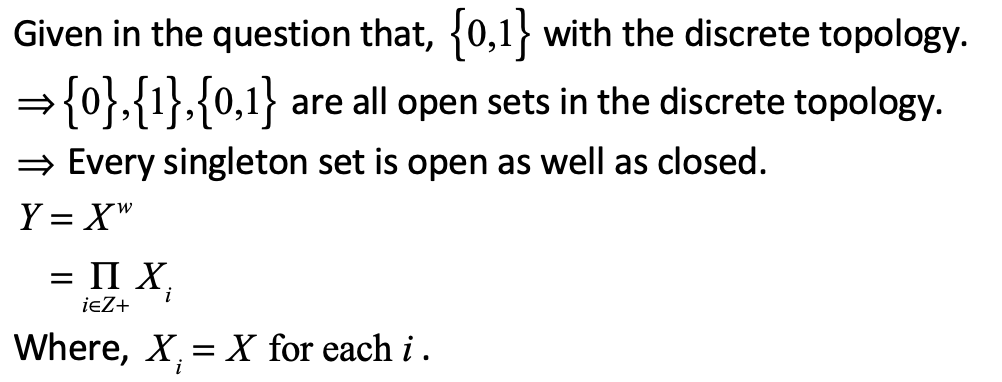Prove the following: Let X denote the set {0,1} with the discrete topology. Let Y = X" = || X; ieZ+ where X; = X for each i. Prove that the product topology on Y is not the discrete topology.
Prove the following: Let X denote the set {0,1} with the discrete topology. Let Y = X" = || X; ieZ+ where X; = X for each i. Prove that the product topology on Y is not the discrete topology.
Advanced Engineering Mathematics
10th Edition
ISBN:9780470458365
Author:Erwin Kreyszig
Publisher:Erwin Kreyszig
Chapter2: Second-order Linear Odes
Section: Chapter Questions
Problem 1RQ
Related questions
Question
![**Problem Statement:**
Prove the following: Let \( X \) denote the set \(\{0,1\}\) with the discrete topology. Let
\[ Y = X^\omega = \prod_{i \in \mathbb{Z}_+} X_i \]
where \( X_i = X \) for each \( i \). Prove that the product topology on \( Y \) is not the discrete topology.
**Explanation:**
This mathematical problem involves proving that the product topology on an infinite product of discrete spaces is not discrete. Here, \( X \) is a discrete space with two elements, 0 and 1. The set \( Y \) is an infinite product of copies of \( X \), indexed by the positive integers \( \mathbb{Z}_+ \).
When dealing with topologies, the discrete topology means that every subset is open. In contrast, the product topology on an infinite product is usually coarser (i.e., has fewer open sets) than the discrete topology, unless the index set is finite. This is because only finite intersections of basic open sets (products where all but finitely many factors are the whole space) need to be in the topology.
The problem requires understanding the distinction between these topologies and exploiting properties of infinite products to demonstrate that the set cannot have the discrete topology.](/v2/_next/image?url=https%3A%2F%2Fcontent.bartleby.com%2Fqna-images%2Fquestion%2F45acd104-f51d-4f09-aed7-d7503d466014%2Fbe62586b-d577-4c3f-a4fe-bb21e358be7b%2Fbotmrr8_processed.png&w=3840&q=75)
Transcribed Image Text:**Problem Statement:**
Prove the following: Let \( X \) denote the set \(\{0,1\}\) with the discrete topology. Let
\[ Y = X^\omega = \prod_{i \in \mathbb{Z}_+} X_i \]
where \( X_i = X \) for each \( i \). Prove that the product topology on \( Y \) is not the discrete topology.
**Explanation:**
This mathematical problem involves proving that the product topology on an infinite product of discrete spaces is not discrete. Here, \( X \) is a discrete space with two elements, 0 and 1. The set \( Y \) is an infinite product of copies of \( X \), indexed by the positive integers \( \mathbb{Z}_+ \).
When dealing with topologies, the discrete topology means that every subset is open. In contrast, the product topology on an infinite product is usually coarser (i.e., has fewer open sets) than the discrete topology, unless the index set is finite. This is because only finite intersections of basic open sets (products where all but finitely many factors are the whole space) need to be in the topology.
The problem requires understanding the distinction between these topologies and exploiting properties of infinite products to demonstrate that the set cannot have the discrete topology.
Expert Solution
Step 1

Step by step
Solved in 3 steps with 3 images

Knowledge Booster
Learn more about
Need a deep-dive on the concept behind this application? Look no further. Learn more about this topic, advanced-math and related others by exploring similar questions and additional content below.Recommended textbooks for you

Advanced Engineering Mathematics
Advanced Math
ISBN:
9780470458365
Author:
Erwin Kreyszig
Publisher:
Wiley, John & Sons, Incorporated

Numerical Methods for Engineers
Advanced Math
ISBN:
9780073397924
Author:
Steven C. Chapra Dr., Raymond P. Canale
Publisher:
McGraw-Hill Education

Introductory Mathematics for Engineering Applicat…
Advanced Math
ISBN:
9781118141809
Author:
Nathan Klingbeil
Publisher:
WILEY

Advanced Engineering Mathematics
Advanced Math
ISBN:
9780470458365
Author:
Erwin Kreyszig
Publisher:
Wiley, John & Sons, Incorporated

Numerical Methods for Engineers
Advanced Math
ISBN:
9780073397924
Author:
Steven C. Chapra Dr., Raymond P. Canale
Publisher:
McGraw-Hill Education

Introductory Mathematics for Engineering Applicat…
Advanced Math
ISBN:
9781118141809
Author:
Nathan Klingbeil
Publisher:
WILEY

Mathematics For Machine Technology
Advanced Math
ISBN:
9781337798310
Author:
Peterson, John.
Publisher:
Cengage Learning,

